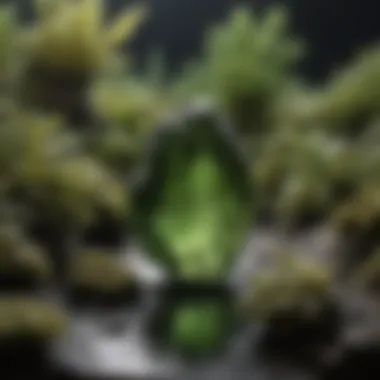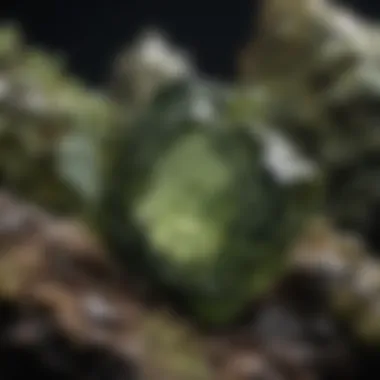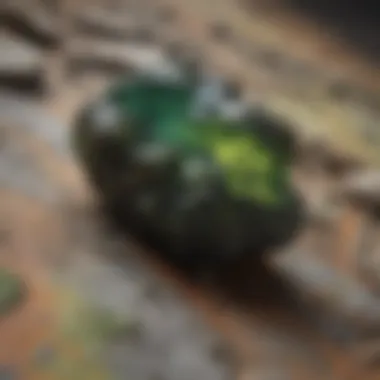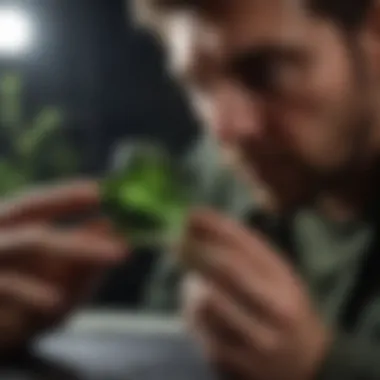Exploring Genuine Czech Moldavite: Origins and Significance


Intro
In the fascinating realm of geological wonders, genuine Czech moldavite emerges as a captivating subject of study. This unique tektite, formed by meteorite impacts, holds both scientific intrigue and cultural significance. With its striking green color and intriguing history, moldavite attracts collectors and enthusiasts alike. This article will navigate through its origins, distinctive characteristics, and relevance in various contexts. Collectors will also find practical information regarding verification methods and market trends throughout the narrative.
Featured Collectible of the Month
Overview
Czech moldavite stands as a prominent collectible item, cherished for its beauty and rarity. Its formation dates back approximately 15 million years, a time when a meteorite struck the Earth, resulting in the melting of surrounding silica-based materials. The rapid cooling and solidification process created the distinctive glassy substance known as moldavite. Each piece presents a rich green hue, often with an alluring translucence. Collectors value moldavite not only for its aesthetic appeal but also for its geological narrative.
Historical Significance
Moldavite has captured the human imagination since ancient times. Its presence in Bohemian folklore ties it to legends of divine origin. Some believe it was created when the meteorite struck, causing the area to be blessed. It has also been associated with various mystical properties, making it a valuable talisman in different cultures. The archaeological findings demonstrate its use in jewelry during the Paleolithic era, highlighting its longstanding allure throughout history.
"Moldavite is often regarded as a stone of transformation, bridging the earthly with the celestial."
Identification Techniques
Visual Characteristics
Identifying genuine Czech moldavite might seem daunting at first but is attainable through careful observation. Key characteristics to note include:
- Color: Typically a deep, translucent green; however, it can also present in shades ranging from olive to a bright emerald.
- Surface Texture: Look for the pitted surface, which is a result of the natural formation process.
- Form: Moldavite often appears in irregular shapes, rather than perfectly polished forms commonly found in synthetic pieces.
- Weight: Given its density, moldavite usually feels heavier than its size suggests.
Resources for Identification
When seeking to confirm the authenticity of moldavite, numerous resources can assist collectors:
- The Geological Society of America: Offers extensive research on tektites and includes accurate identification techniques.
- Moldavite-related Reddit Forums: Engaging in community discussions can provide insights and tips from other enthusiasts.
- Local Gem and Mineral Shows: Attending events offers opportunities to interact with experts.
- Facebook Groups dedicated to Moldavite: Several groups provide a platform for sharing experiences, asking questions, and seeking advice on authenticating pieces.
In this exploration of genuine Czech moldavite, we uncover its origins, characteristics, and significance—all essential components for collectors aiming to deepen their appreciation for this remarkable natural wonder.
Intro to Czech Moldavite
Understanding Czech moldavite is essential for collectors and enthusiasts alike. This unique tektite is not merely a geological curiosity; it embodies a complex interplay of natural history and cultural significance. The appeal of moldavite goes beyond its beauty; it reflects significant events in Earth's history and holds potential spiritual meanings. Curators and collectors should appreciate the nuanced aspects of this stone to make informed choices.
What is Moldavite?
Moldavite is a greenish, glass-like substance that was formed over 15 million years ago due to a significant meteorite impact in the region now known as the Czech Republic. It is classified as a tektite, which are natural glass formed from the intense heat and pressure of meteorite impacts. The process produces unique pieces that have various colors, shapes, and sizes. Unlike many gems, moldavite’s distinct features come from its extraterrestrial origins, which lend it a particular charm and intrigue. It is sought after not just for its aesthetics but also its unique story, often resonating well with those who appreciate geological marvels.
Historical Context
The significance of moldavite transcends geological aspects; it is steeped in cultural history. Evidence suggests that moldavite was used by ancient civilizations for various purposes. During the Stone Age, it was crafted into tools and ornaments, likely due to its rarity and beauty. This suggests an early recognition of its value. Throughout history, moldavite has appeared in folklore and mythology, often regarded as a stone of transformation. In modern times, it has gained popularity among collectors and spiritual practitioners who believe in its properties for healing and personal growth. Understanding this cultural context aids collectors and enthusiasts in valuing moldavite not only as a collector’s item but also as a piece of shared human history.
Geological Origins of Moldavite
The geological origins of Moldavite are essential for understanding its unique properties and significance. Formed around 15 million years ago, this extraordinary green gemstone is a product of cosmic cataclysm. Exploring the processes behind its formation gives insight into both its rarity and its appeal among collectors interested in meteorites and natural history.


Formation Process
Moldavite formed during a meteorite impact on Earth. When the meteor struck the Bohemian region, its immense energy caused terrestrial silica-rich materials to melt and vaporize. As these materials cooled and solidified, they created glassy, olive green fragments now known as Moldavite. This process is similar to how other tektites are formed; however, Moldavite is unique due to its specific geography and chemical composition. The high temperatures involved during the impact ensure that Moldavite has a distinct texture and an unusual internal structure.
Not only is its formation fascinating, but it also contributes to its market value. With every new discovery of Moldavite, buyers become more aware of its geological process, emphasizing the need for careful collection and purchase. Considering the formation process is critical when assessing authenticity, as genuine Moldavite undergoes this rare cosmic event while many imitations do not.
Significance of Impact Events
The significance of impact events in the creation of Moldavite cannot be overstated. These occurrences provide crucial geological insights into Earth's history and the dynamics of our solar system.
- Cosmic Insights: Impact events help scientists understand how Earth interacted with other celestial bodies. The presence of Moldavite indicates that other forms of matter may have entered the Earth's atmosphere.
- Geological Studies: Collectors and researchers alike appreciate Moldavite as it serves as both a geological specimen and a collector's item. Its unique origin provides ample discussion points in both scientific and casual settings.
- Elemental Composition: The distinct elements found in Moldavite, stemming from extraterrestrial materials, allow for analysis of its formation and help define the mineral's chemical properties.
"Moldavite represents a fascinating intersection of geology and cosmic phenomena, making it an essential subject for both collectors and scientists."
The impact events that produced Moldavite emphasize the interconnectedness between cosmic phenomena and geological processes, thus highlighting its significance beyond mere aesthetics. This context is invaluable for those who seek to grasp the depth of what makes Moldavite a sought-after specimen in the field of gemology.
Characteristics of Genuine Czech Moldavite
Understanding the characteristics of genuine Czech Moldavite is crucial for both collectors and enthusiasts. These features define the quality, genuineness, and overall desirability of this unique tektite. Moldavite’s characteristics not only serve as a foundation for identification but also play a significant role in its cultural and scientific relevance. Examining these properties provides insight into what separates genuine moldavite from imitations.
Physical Properties
Color Variations
Color variations in moldavite are one of its most striking characteristics. These colors can range from deep olive green to lighter shades and even yellowish hues. The rich green tones often hold a higher value due to their rarity and beauty. The specific aspect of color contributes greatly to the overall appeal of moldavite in the market.
Key characteristic: The deep greens enhance its allure and marketability. Collectors often prefer deeper shades.
Unique feature: Color variations can indicate the quality and geological source of the moldavite.
Advantages: Beautiful colors can make for appealing displays or personal jewelry. However, lighter colors may be less sought after.
Transparency Levels
Transparency levels in moldavite vary widely. Some pieces are nearly translucent, while others can be nearly opaque. This aspect influences the aesthetic appeal of the stone as well. Generally, higher transparency can increase the value of the pieces, appealing more to collectors.
Key characteristic: High transparency can reveal the unique inclusions and textures within the stone.
Unique feature: Transparent moldavites often show stunning light effects that enhance their charm.
Advantages: A more transparent stone may carry a higher price but could be more fragile and susceptible to scratches.
Texture and Surface Patterns
Moldavite exhibits various textures and surface patterns which add intrigue to each specimen. These patterns can be caused by its formation process and can often include flow lines and striations. Understanding these textures provides additional context for both scientific study and collecting.
Key characteristic: Unique surface textures help identify genuine pieces.
Unique feature: Each moldavite can display individual patterns, making each piece unique.
Advantages: Irregularities can showcase nature's artistry; however, some might prefer cleaner surfaces for aesthetic reasons.
Chemical Composition
The chemical composition of moldavite is primarily silica, with varying amounts of aluminum, iron, and other trace elements. This specific makeup is indicative of its formation during a meteorite impact. Understanding the chemical composition enhances knowledge about its origins and helps in differentiating between genuine and counterfeit moldavite.
While the unique properties of moldavite make it significant not only as a collector's item but also as a subject of scientific study, it is the interplay of these characteristics that attract individuals to moldavite. Collectors and enthusiasts are drawn to both its beauty and the stories it tells about Earth's history.
Cultural and Spiritual Significance
Czech moldavite has long been a subject of intrigue and reverence across various cultures. Understanding its cultural and spiritual significance allows collectors and enthusiasts to appreciate not just its physical properties, but also the rich narrative embedded within its very essence. The ways in which moldavite has been integrated into human history is of great relevance, as it ties together the geological with the metaphysical.


Moldavite in Ancient Cultures
In ancient cultures, moldavite was often viewed as more than a mere stone. Archaeological findings suggest that moldavite was utilized by the Celts in ceremonial contexts. They believed it held protective qualities. Jewelry made from moldavite was frequently associated with status and spiritual rituals. The connection with celestial events further enhances its meaning. As a product of a meteorite impact, moldavite is perceived by some as having cosmic energy.
Many artifacts found in ancient burial sites contain moldavite. These findings imply that it was honored in rites of passage, possibly for its supposed ability to connect the mortal with the divine. The reverence for this stone also extends to various local legends which describe it as a gift from the heavens, adding layers to its mythical narrative.
Modern Day Beliefs and Practices
Today, moldavite continues to captivate the modern spirit, often regarded as a powerful gem in the realm of metaphysical properties. New age beliefs frame it as a stone of transformation and spiritual awakening. Practitioners of meditation and other spiritual practices frequently use moldavite to enhance their experiences. They often claim it facilitates a connection to higher realms.
Collectively, users of moldavite assert it assists in release from outdated patterns or energies. This potential for personal evolution makes moldavite a sought-after stone among spiritual practitioners and collectors alike. Some modern believers also consider moldavite to have protective and healing properties, enhancing its desirability in the spiritual community.
"Moldavite is not just a stone; it is a key to unlocking personal transformation and awareness."
The interplay between its ancient significance and contemporary beliefs creates an ongoing narrative that elevates the value of moldavite, not just as a collectible, but as a token of spiritual meaning. As interest in holistic and spiritual wellness grows, rather more find value in integrating moldavite into their lives, further cementing its importance in both history and modernity.
Identifying Genuine Moldavite
Recognizing genuine Czech moldavite is crucial for collectors and enthusiasts. The market has seen an influx of counterfeits, making it imperative to understand how to identify authentic specimens. Genuine moldavite holds significant value, not only for its beauty but also for its rarity. Thus, identifying it accurately ensures that collectors protect their investments. This section delves into common counterfeits and various methods for verification, each providing insight into the authenticity of moldavite.
Common Counterfeits
Counterfeits of moldavite can often pass as genuine to the untrained eye. Some common types include:
- Glass Imitations: Many sellers offer pieces made from colored glass that resemble moldavite.
- Synthetic Moldavite: Created in labs, these pieces may mimic authentic moldavite but lack the natural formation patterns.
- Other Tektites: Some tektites from different locations might be sold as Czech moldavite. It is essential to know the specifics.
Understanding the traits of these counterfeits can save collectors from disappointment and financial loss.
Verification Techniques
Verification of moldavite can be accomplished through several techniques. Here are three popular methods:
Visual Inspection
Visual inspection is often the first step in identifying genuine moldavite. One of the key characteristics of authentic moldavite is its unique surface texture, which can have a "brain-like" shape known as moldavites' nicks. This method is beneficial for novices and seasoned collectors alike since it requires no special tools. However, the limitations of visual inspection exist, as accidental damage or poor lighting conditions may obscure genuine details.
Observing closely under proper light can reveal inclusions or transparency levels that are difficult to replicate.
UV Light Test
The UV light test serves as another effective technique for validating moldavite. Genuine moldavite exhibits distinctive fluorescence under ultraviolet light. The key characteristic is its green glow, which differentiates it from many other materials. This test is popular due to its simplicity and non-destructiveness.
However, while the test is simple, it may still yield false positives if the light used is of incorrect wavelength or if other materials are tested. A consistent and controlled method increases accuracy in results.
Density and Weight Testing
Density and weight testing provides a quantitative approach to identifying genuine moldavite. Authentic moldavite has a specific density, typically around 2.3 to 2.4 g/cm³. This testing method involves measuring the weight of the specimen and calculating its volume, then using the density formula.
The benefit of this technique lies in its objectivity, as it provides numerical results. However, the required tools, such as a precise scale and a graduated cylinder, can be cumbersome for casual collectors. Still, this method stands out in terms of accuracy when done properly.
Identifying genuine Czech moldavite involves understanding its features and employing multiple verification techniques, ensuring collectors make informed purchases.
The Market for Moldavite
The market for moldavite has evolved significantly over the years, reflecting both its natural allure and the growing interest among collectors. Understanding this market is essential for anyone invested in moldavite, be they collectors, investors, or enthusiasts. The unique attributes of this tektite connect both its geological significance and cultural heritage to market value. Here, we explore current market trends and discuss the investment potential surrounding genuine Czech moldavite.


Current Market Trends
Moldavite is currently experiencing a resurgence in popularity. Recent trends indicate an increase in demand, driven largely by those who appreciate its rarity and unique qualities. Key factors influencing the current market include:
- Rarity: Genuine moldavite can be difficult to find, especially larger pieces. This rarity contributes to its higher value.
- Online Platforms: The advent of online buying forums, such as eBay and specialized crystal stores, allows collectors access to a broader range of moldavite specimens.
- Social Media Influence: Platforms like Instagram and Facebook have created communities centered around moldavite, showcasing its beauty and increasing visibility.
- Educational Resources: Increased awareness of moldavite's geological significance has led many to seek it out for both collection and investment.
These trends reflect a shift in perception towards moldavite, from merely a collector's item to a sought-after asset with emotional and financial value.
Investment Potential
Investing in moldavite poses unique opportunities as well as risks. The market is still fairly niche, but its distinctiveness can lead to favorable long-term returns when approached carefully. Considerations for potential investors include:
- Value Appreciation: As genuine moldavite becomes scarcer, the potential for value appreciation increases. Collectible items like moldavite often do not depreciate, making them a viable alternative investment.
- Market Volatility: While the appeal remains strong, fluctuations can occur based on trends and demand. Investors should be cautious and informed to navigate potential downturns.
- Authenticity: With the rise in popularity comes the increase in counterfeit products. Investors must ensure they purchase verified genuine moldavite to preserve asset value.
Investing in moldavite is not just a transaction; it is an engagement with a piece of history and nature.
By keeping an eye on these trends and understanding their implications, collectors and investors can make well-informed decisions regarding their moldavite journeys.
Care and Preservation of Moldavite
Understanding how to properly care for and preserve Czech moldavite is essential for collectors. The process ensures that the unique features and value of this rare tektite remain intact over time. Moldavite, while beautiful, is relatively soft compared to many gemstones. Hence, careful handling and specific storage and cleaning methods are needed to prevent damage.
Storage Recommendations
When storing moldavite, it is critical to choose a suitable environment. The following recommendations can help maintain the quality of your stone:
- Use Soft Pouches: Wrap the moldavite in a soft cloth or place it in a padded pouch. This minimizes the risk of scratches.
- Avoid Direct Sunlight: Store moldavite in a dark place, away from direct sunlight. Prolonged exposure can lead to fading or damage.
- Controlled Humidity: Aim for stable temperature and humidity levels. Sudden changes can cause stress on the mineral.
- Separate Storage: Keep moldavite away from other jewelry or stones. This helps prevent any potential scratching from harder minerals.
Storing in a dedicated display case can also add aesthetic value while providing protection.
Cleaning Methods
Keeping moldavite clean is equally important. However, the cleaning process must be approached with care:
- Gentle Soaking: If dirt accumulates, soak the moldavite in lukewarm, soapy water for a few minutes. Use a mild detergent to avoid harsh chemicals that might react with the stone.
- Soft Brushes: After soaking, use a soft toothbrush or a jewelry brush to gently scrub the surface. This helps remove any stubborn dirt without damaging the stone's texture.
- Rinse Thoroughly: Ensure that no soap residue remains. Rinse thoroughly under lukewarm running water.
- Pat Dry: Use a soft cloth to pat the moldavite dry. Avoid rubbing it harshly, as this may scratch the surface.
"Proper care and preservation not only enhances the beauty of moldavite but also its longevity as a collectible."
By following these care guidelines, collectors can ensure that their Czech moldavite retains its appeal and value over time.
Finale
In summarizing this article about genuine Czech moldavite, it is clear that this unique tektite offers more than just visual appeal. Understanding its origins, characteristics, and significance enables collectors to appreciate moldavite on a deeper level. Moldavite connects earth's geological events with human history and spirituality, making it a fascinating subject for both scientific study and cultural exploration.
Summary of Key Points
- Geological Background: Moldavite formed about 15 million years ago as a result of a meteorite impact, which is crucial for its distinct properties.
- Characteristics: Genuine moldavite displays various hues, transparency levels, and unique surface textures. Recognizing these traits is essential for verifying authenticity.
- Cultural Significance: Ancient cultures valued moldavite for spiritual purposes, while contemporary beliefs further enhance its allure among collectors.
- Market Dynamics: Understanding current market trends and investment potential is vital for informed purchasing decisions.
- Preservation Tips: Proper care and maintenance ensure that moldavite pieces remain in optimal condition for collectors.
Final Thoughts on Collecting Moldavite
Collecting moldavite should be approached with a balance of passion and caution. Knowledge gained from understanding its science and cultural background can significantly enhance the experience.
When acquiring moldavite, it is advisable to rely on reputable sources and verify authenticity using established techniques like visual inspection and density tests. The collectible market for moldavite has seen fluctuations, so awareness of market trends is also beneficial.
Ultimately, genuine Czech moldavite not only serves as a striking natural artifact but also symbolizes a larger connection to both ancient and modern human narratives. Embrace the opportunity to own a piece of earth's history, while ensuring careful stewardship of its preservation for future generations.



